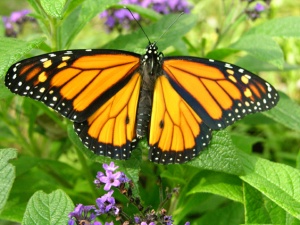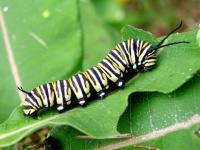User:StevenHovorka
October 11, 2007
It’s autumn and nature is preparing for the winter chill. Leaves are falling, squirrels are preparing to hibernate, and birds of all kinds are traveling across the country to find a warm place to spend the winter. Another migrant not much thought of is the Monarch Butterfly (Danaus plexippus). Most people have seen a Monarch Butterfly, whether they know it or not. It is one of the best known lepidoptera (scientific name for the order of insects that include butterflies and moths), and one of the most unique. It has orange wings with black boarders. Its body is black and has several white spots near the head. The caterpillar of the Monarch is colorful as well, with alternating black, white and yellows stripes running all down its body.
Monarchs, like all insects, are cold-blooded, which means they can’t produce their own body heat the way humans can. They get all their warmth from the environment around them. If it is too cold outside, the butterflies cannot move, let alone fly. For this reason, they have to either find a way to overwinter or die. Monarchs solve this problem by migrating en masse to forests in Mexico to spend the winter months. Even more amazing, each year is a new generation of Monarchs, and they all return to the same place every year from all across North America. How they manage this is still a mystery.
Right now the butterflies can be seen in traveling through New England. Soon, they will have all passed through the area, and we won’t see them again until next year. To find them, look for plants that are still flowering, as the Monarchs will have to feed and fatten on their journey south.
Want more information? Check www.monarchwatch.org.

